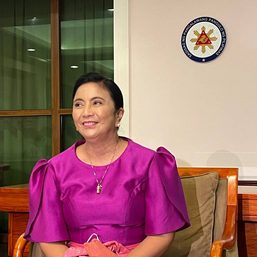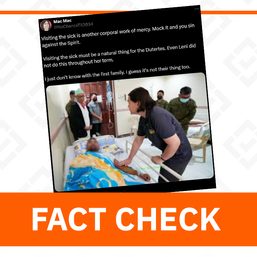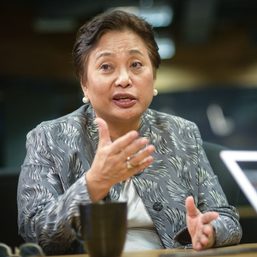SUMMARY
This is AI generated summarization, which may have errors. For context, always refer to the full article.
![[Newsstand] To win, Leni Robredo needs 22 million votes](https://www.rappler.com/tachyon/2022/03/tl-leni-votes.png)
The surge in support for Vice President Leni Robredo’s candidacy is real, though it has yet to be reflected in a publicly available scientific survey. The large rallies and the pivotal declarations of support from local officials are only the most audible signals in all the election noise. It may only be a question of time, or the lack of it: Is there enough time for the momentum to swing all the way to victory?
But I find it unhelpful, and even unhealthy, to think in terms of only one hue of pink as a symbol of support; to say, for instance, that after the massive rally in Malolos on March 5 and the declaration of support from Governor Dan Fernando on March 14, “Bulacan is pink.” I can understand why it is said; it is both rightful recognition (of a partial fact) and rah-rah rhetoric (to boost morale and drive the campaign). But the reality is there are various shades of pink – and Robredo doesn’t need all provinces and cities to turn full pink.
How many votes does Robredo need in order to win the presidency? I will try to answer this using regional vote totals.
But first, two crucial assumptions.
After the initial shock of unprecedented majority ratings in election preference surveys for Ferdinand Marcos Jr., the presidential race will revert to form; the winning candidate will end up, more or less, with a 40-percent mandate, just like Erap Estrada, Gloria Arroyo, Noynoy Aquino, and Rody Duterte. For the purpose of discovering a path to victory for Robredo, I will assume that she will need to win at least 41 percent of the vote; in this scenario, multiple factors, including a surge in last-minute votes for Isko Moreno, will help drag Marcos Junior’s support down to 40 percent.
I will also assume that, with a few adjustments, Robredo will follow more or less the same trail to victory she blazed in 2016. This means winning the same nine regions she won, by about the same margins, and then holding her own in other regions. (She won a 10th, the Negros Island Region, but it has since been re-assimilated into Regions VI and VII).
This second assumption has less history behind it as the first; but as I hope will become clear, the underlying premises are reasonable and their implied calls to action doable.
Bailiwicks
Embedded below is the simple election calculator I used to compute for the totals.
The official count is 65,745,529 registered voters for the 2022 elections. In the last presidential election, 81.95 percent of all voters were able to cast their ballots. Assuming an 81-percent voter turnout rate, we are looking at 53,253,879 votes cast in 2022. And 41 percent of that is 21,834,090. To simplify, let us assume that Robredo needs 22 million votes to win on May 9.
Where will she get those votes? We start with her bailiwicks, the two regions where she won more than half of all votes cast for vice president in 2016.
Region V, Bicol, has a reputation for cohesive support of Bicolanos running for national office. In 2016, 63.88 percent of the votes cast for vice president in Bicol went to Leni; about 25 percent went to Chiz Escudero, Sonny Trillanes, and Gringo Honasan. With no Bicolano to split the vote with her this year, it is reasonable to assume that Robredo will receive a higher share of support. Assuming an 85-percent turnout (about the same as in 2016), and 90-percent support (like Duterte in Region XI in 2016), Robredo can win 2.99 million votes.
Region VI, Western Visayas, which includes the cities of Bacolod and Iloilo, gave Robredo Bicol-level support in 2016 as the running mate of favorite son Mar Roxas; 65.22 percent of the votes cast went to her. As the massive rallies in those cities and the sustained frenzy of campaigning in the region show, she continues to enjoy outstanding support. Assuming an 85-percent turnout (almost the same as in 2016), and 75-percent support, Robredo can win 3.20 million votes.
Together, these two regions can give her 6.20 million votes.
Strong showing
The other regions Robredo won in 2016, all by plurality, were Central Visayas, Calabarzon, Mimaropa, Zamboanga Peninsula, Northern Mindanao, Caraga, and what is now the Bangsamoro Autonomous Region in Muslim Mindanao (BARMM).
Region VII, Central Visayas, gave 41.25 percent of votes cast to Robredo. She continues to poll well in Cebu City, but is now lagging in the rural areas. Assuming an 85-percent turnout (as in 2016), and with 50-percent support, Robredo can win 2.23 million votes.
Region IV-A, which includes Cavite, Laguna, Batangas, Rizal, and Quezon, is by far the most vote-rich region. In 2016, Robredo won 33.92 percent of the votes. Assuming a 75-percent turnout (down from 77.81 percent in 2016), and with only 30-percent support, Robredo can win 2.07 million votes.
Region IV-B, which includes the two Mindoros, Marinduque, Romblon, and Palawan, voted for Robredo in 2016 with a large plurality of almost 44 percent. Assuming an 80-percent turnout (down from 81.46 percent), and with 40-percent support, Robredo can win 637,000 votes.
The four regions in Mindanao which Robredo won in 2016 gave her about 3 million votes. But she won Regions IX, X, and Caraga with modest pluralities; it was only in ARMM where she won with a large plurality. Assuming slightly lower voter turnout in each of these four regions, and with similar or lower levels of support (38 percent in both Regions IX and X, 39 percent in Caraga, 40 percent in BARMM because of enthusiasm and support for Moreno), Robredo can win 3.04 million votes.
All told, given reasonable adjustments in three regions and similar or lower assumptions in the other six, Robredo can win 14.18 million votes from the regions she topped in 2016.
Other areas
Assuming both the same turnout rates and the same percentage of votes cast in 2016, Robredo can win 763,000 votes in Northern Luzon (CAR, Regions I and II), 942,000 votes in Region VIII, and 988,000 votes in Regions XI (Duterte country) and XII.
The most vote-rich regions next to Calabarzon are the National Capital Region and Region III. In 2016, Robredo won about 28 percent of the votes cast for vice president in each of those regions. Assuming the same turnout (78 percent for Metro Manila, 82 percent for Central Luzon), and with the same level of support, of 28 percent, Robredo can win 3.27 million votes.
That brings Robredo's total to 20.19 million votes, or 38 percent. Despite higher percentages assumed for Regions V, VI, and VII, and similar or lower assumptions for all other regions, she would still come up about 2 million votes short.
Where can she source those additional votes? She'll need to do much better in Central Luzon, NCR, and Region XI. If she can push her vote percentage in both Region III and NCR to 40 percent (up from 28), and in the Davao region to 30 percent (doubled from 14), she will get 22 million votes.
But as the calculator should remind us, a small percentage change can carry major consequences. Pink, like any other color, has many shades.
Cavite, for instance, has 2.30 million voters registered for 2022. In 2016, it had a voter turnout of 75.43 percent. Assuming 75 percent will cast their vote on May 9, that's a total of 1.73 million votes. The Remullas can very well make good on their promise to get 800,000 votes for Marcos Junior; that's up from around 550,000 in 2016. But that in itself is not necessarily bad news for Robredo, who got about 400,000 votes the last time around. With the successful rallies and the switching of key local officials, she can raise her previous total by say 50 percent, to 600,000 – she may not "win" Cavite, or Bulacan (which has roughly the same configuration), but that doesn't mean Cavite or Bulacan won't play their role in an overall victory.
But it seems clear to me: Faced with difficult choices about areas to visit in the last several weeks of the campaign, Robredo should decide, more often than not, in favor of Calabarzon, NCR, and Central Luzon: That's where the proverbial needle has most room to move. – Rappler.com
Veteran journalist John Nery is a columnist and editorial consultant of Rappler.
Add a comment
How does this make you feel?
![[WATCH] In The Public Square with John Nery: Preloaded elections?](https://www.rappler.com/tachyon/2023/04/In-the-Public-Square-LS-SQ.jpg?resize=257%2C257&crop=414px%2C0px%2C1080px%2C1080px)
![[Newspoint] 19 million reasons](https://www.rappler.com/tachyon/2022/12/Newspoint-19-million-reasons-December-31-2022.jpg?resize=257%2C257&crop=181px%2C0px%2C900px%2C900px)

![[OPINION] The long revolution: Voices from the ground](https://www.rappler.com/tachyon/2022/06/Long-revolution-June-30-2022.jpg?resize=257%2C257&crop=239px%2C0px%2C720px%2C720px)
![[OPINION] I was called a ‘terrorist supporter’ while observing the Philippine elections](https://www.rappler.com/tachyon/2022/06/RT-poster-blurred.jpeg?resize=257%2C257&crop_strategy=attention)
![[Newspoint] Improbable vote](https://www.rappler.com/tachyon/2023/03/Newspoint-improbable-vote-March-24-2023.jpg?resize=257%2C257&crop=339px%2C0px%2C720px%2C720px)




![[OPINION] Sara Duterte: Will she do a Binay or a Robredo?](https://www.rappler.com/tachyon/2024/03/tl-sara-duterte-will-do-binay-or-robredo-March-15-2024.jpg?resize=257%2C257&crop_strategy=attention)
![[New School] Tama na kayo](https://www.rappler.com/tachyon/2024/02/new-school-tama-na-kayo-feb-6-2024.jpg?resize=257%2C257&crop=290px%2C0px%2C720px%2C720px)


There are no comments yet. Add your comment to start the conversation.